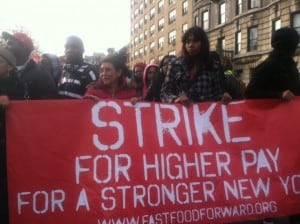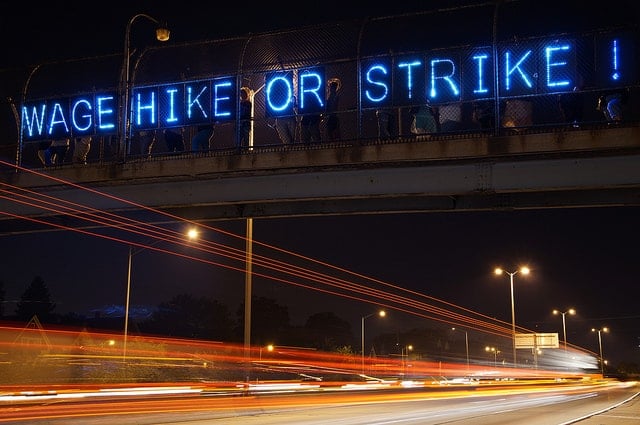September is a month of transitions. Summer is over, but not quite. Seasons are changing; days are equally crisp and cool, warm and muggy. Winter is coming, but pumpkin spices keep it at bay for another few weeks.1
Labor Day traditionally marks the “unofficial” end to the summer season and the last real communal revelry until the holiday season at the end of the year. It is an odd duck of a holiday, ending a season of vacation and time away from work with a celebration of workers and the benefits they bring to our communities. Odd maybe, but often more and more relevant as the struggles of the labor movement fade into history.
This year, though, that fade was — however briefly — halted. Beginning earlier this summer, fast food workers across the United States began a series of labor actions aimed at improving wages and conditions. Everything culminated in a series of strikes, sit-ins, and other actions at numerous fast food franchises in over 100 cities. Several groups of organizers have documented many of these stories on the web and social media (#StrikeFastFood). They called for serious improvements in the quality of working conditions. Perhaps at the top of this list is the call for higher pay. A $15 minimum wage has been a clarion call, along with demands for health insurance and other benefits.
The history of the labor movement has often been a history of civil disobedience and the use of the legal system as a tool on both sides. Such is equally true today. #StrikeFastFood highlights the use by labor leaders of the National Labor Relations Board to seek improvement in the lot of the average worker. At the end of July, they scored a major victory when the NLRB ruled that McDonald’s could be held accountable, at least in part, for the behavior of its nominally independent franchise owners. McDonald’s can, of course, challenge that decision; expect lawsuits either way. During the recent strike, however, corporate leaders invoked the specter of civil unrest and disobedience, and the result was arrests across the country. The exact number and causes of arrests have varied depending on whom one talks to.
As several of these stories have noted, this is only the most recent example of a long-term strategy to improve the lives of fast food workers. This includes not only #StrikeFastFood but also campaigns such as “Justice for Janitors.” Traditionally, the labor movement was a movement of factory workers and of industry (think Detroit). In the last part of the twentieth century, organized labor was the domain of government (think public school teachers). Both of those models are vanishing due to complex changes in the corporate sphere and the antagonism of conservative political parties to public unions. It may be that the future of unions is in the ever-growing service industry.
Regardless of the future, the present indicates that there is still fight left in the labor movement. Having spent the last few years pushing forward on improving the lot of workers at the bottom of the socio-economic ladder, #StrikeFastFood appears to at least be somewhat successful. Indeed, Jordan Weissman, writing in Slate, considers it to be a “stunning” success. He points out that although we haven’t seen the unionization of the local burger franchise, the campaign has changed the course of the debate over the last few years.
Over roughly the past two years, 13 states have increased their minimum wage, as have 10 city and county governments, according to a tally by NBC News. Seattle voted to raise its citywide minimum to $15 an hour by 2018… The mayors of New York, Los Angeles, and Chicago have all backed a $13 wage floor. The president has come out in favor of a $10.10 national minimum…You don’t have to think a $15 minimum wage is a brilliant idea (personally, I don’t) to admire the efficacy of the effort.
As Weissman notes, you don’t have to fully support the specific goals of these movements to admire them. Moreover, you don’t have to fully support their goals to realize that a resurgent labor movement is a good thing — a counterbalance to increasingly monolithic corporate powerhouses and a mediating institution for a seemingly voracious public sector. Justice — for janitors, chefs, teachers, sales clerks, or, yes, factory workers — is an important element, a constituent element of a just public order. And, in many ways, the current climate seems to ignore this.
Only a few weeks before the recent strikes, the New York Times Magazine illustrated some economic injustices. “Working Anything But 9 to 5” it proclaimed as it dissected just how viciously efficient Starbucks is at scheduling workers. Electronic monitoring finds the most efficient way to use these “human resources.” Alas, they often become “resources” first and “human” second, if at all. Jannette Navarro, profiled in the story, tells of having to put her life on hold. Her scheduled hours were too unstable to commit to a class schedule. Moreover, since she rarely knew far enough in advance, she struggled to schedule babysitters. She was even too afraid to ask for stable hours, fearing she would end up losing hours. Computers can “choreograph[] workers in precise, intricate ballets, using sales patterns and other data[.]” Quite a counterpoint to Starbucks’s recent announcement regarding college education for workers.
Treating a person as though she were interchangeable with every other person is ghastly. People are neither cogs nor widgets. It may be efficient to force a parent to work back-to-back shifts one week, and shifts on opposite sides of the next, but it isn’t fair, not when stability is needed to ensure appropriate childcare, access to further education, or just old fashioned rest, recuperation, and relaxation.
Perhaps even more frustrating, however, is the fact that the law, too, often prioritizes other interests over and above the individual worker. Part of that dates back to the Taft-Hartley Act, which limited the power of labor unions and removed many of their tools out of an effort to protect the rights of business owners and government leaders in the aftermath of post-World War II strikes. But the trend only increased since then.
Take, for example the Supreme Court’s recently decided case, National Labor Relations Board v. Noel Canning. Noel Canning involved what is known as the “Recess Appointments Clause.” The National Labor Relations Board oversees the relationship between unions and businesses. Usually, it is made up of five board members, each one appointed by the President and confirmed by the Senate. In the last few years, nasty politics led to the Senate being unable to even vote on whether to confirm nominees. Towards the end President Bush’s term, the Board no longer had enough members for a quorum. President Obama attempted to break the stalemate by appointing members during what he claimed was to be a Senate recess.

By peoplesworld / Flickr CC
This became an issue when Noel Canning, a distributor for Pepsi, was brought before the Board on an unfair labor complaint. Its facility workers are represented by the Teamsters. The two sides had entered into a collective-bargaining agreement. However, Noel Canning refused to put the agreement in writing or execute it; the union thus brought a complaint. The Board concluded2 that Noel Canning was acting unlawfully. On appeal, Noel Canning argued that the President’s actions had been unconstitutional and that the Board members were not legitimately appointed. The Court concluded the appointments were invalid.3 A straightforward, if arcane, application of constitutional interpretation.
Notice that the appeal and the Court’s decision do not focus on the activities of Noel Canning. This employer did not offer a reason to the Court for its behavior. It did not justify it or try to explain how it was not acting unlawfully. Rather, it focused on things entirely outside the control of the workers whose rights were being affected. Lost, alas, were the workers and the union. The NLRB did not go after Noel Canning on a lark, or just to be anti-business. Rather, they were ruling on a complaint that Noel Canning broke the law. Questions about process and constitutional structure are important and necessary. But, what about the employees who bargained in good faith with an employer who then ignored the agreement? What role is there for them? Employees, and the questions that would be raised by acknowledging them, can lie just beyond the Court’s concern.
It is not a matter of sidelining questions about constitutional procedures, the freedom of association, or even of the rights of owners or economic efficiency. Each of those is an important question and a necessary component to a fair and just society. However, to consider them the only questions is just as bad as omitting them. They must be supplemented by concern for the workers.
Moreover, this concern should be a fundamental part of the analysis, not simply an afterthought. When a manager looks at scheduling his staff, it should not end with mathematical precision. Algorithms should be supplemented by human need. Owners have legitimate concerns about the bottom line, but they should not set wages simply on what is the lowest the market will bear, but by also considering what the needs of an employee and her family will be. And judges should not content themselves with a blind adherence to the abstraction of rules, but should factor in how those rules will apply in practice to help or hinder the concrete lives of workers.
At the end of the day, it will never be that workers or labor unions get an automatic pass, that any demand is immediately met. Demands may be illegitimate, irrational, or just plain unworkable. And, it may also be that legitimate, rational, and practical demands are set aside due to other legitimate concerns. This is not a problem. The problem, rather, is when the demands of the worker are ignored or set aside, taken to be of no value. If we are to be concerned with a fair and just system, then we should commit to placing the needs, desires, and dignity of workers at the heart of our economic, legal, and business analysis.
- Or, as one friend giddily posted on the Facebooks a few days ago, “only 16 Fridays till Christmas!”. ↩
- You can find and download the decision at this link; scroll to the bottom of the page and the decision is number 4. ↩
- Oddly, the result was unanimous, but the Court split 5-4 on the rationale. The more liberal members had a majority that invalidated these appointments but tried to limit the amount of mischief the Senate might try in the future. ↩



